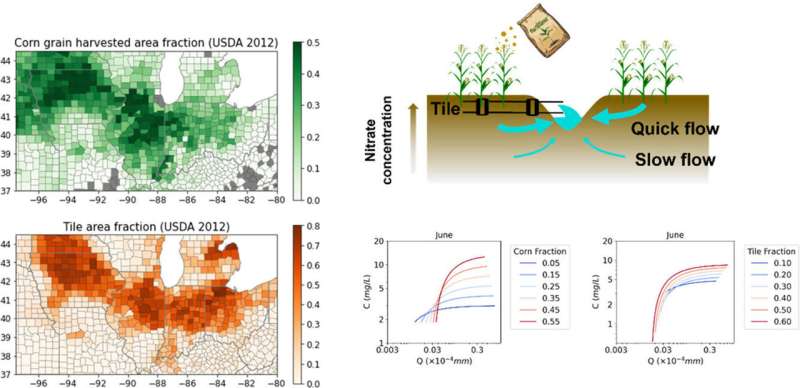This article has been reviewed according to Science X's editorial process and policies. Editors have highlighted the following attributes while ensuring the content's credibility:
fact-checked
trusted source
proofread
Study forecasts tile drainage and crop rotation changes for nitrogen loss

Midwestern agriculture contributes the vast majority of nitrogen in the Gulf of Mexico, causing an oxygen-starved hypoxic zone and challenging coastal economies. State and federal policies have tried for decades to provide solutions and incentives, but the hypoxic zone keeps coming back. A recent study from the University of Illinois offers a new way to understand Midwestern nitrogen dynamics and forecasts future nitrogen loads under various management scenarios across the region.
"Our model explains what's going on across 83 watersheds in the Midwest, providing a quantitative understanding of why certain watersheds differ in terms of nutrient loss. But the most important contribution is our scenario prediction, which hasn't been done before. If you increase tile drainage or the corn fraction, how much does the nitrogen load change? We can predict that, and I think that is really exciting," says Kaiyu Guan, associate professor in Department of Natural Resources and Environmental Sciences (NRES), founding director of the Agroecosystem Sustainability Center (ASC), and senior author on the study.
Guan says a more detailed understanding of nitrogen and water flow dynamics, as well as the ability to forecast the impact of management changes, is a critical step in developing effective policies for nutrient loss reduction from field to watershed scales.
The research team analyzed the relationship between daily flow rate and nitrate concentration across 83 Midwestern watersheds, finding a universal pattern throughout the region: nitrate increases with flow before leveling off at a high flow threshold.
"To further unpack this pattern, we built a simple yet elegant model that reveals the mechanism. We looked at the contributions of shallow soil water, which has a greater flow rate and more nitrate, and deep soil water, with a slower flow and lower nitrate," says Zewei Ma, doctoral student in Guan's group and first author of the study. "The contributions from these areas of the soil profile change depending on the tile drainage and how much corn is planted."
Guan says the more tile drainage is installed and the more corn is planted in a given watershed, the greater the nitrate load in the water. That conclusion isn't new, but the ability to forecast the impacts of increased tile installation or changing levels of corn is. The team created an interactive map to show how and where a 10 to 30% increase in tile or a 20% increase or decrease in corn will change nitrate loading.
"This model gives us a starting point for a meaningful discussion about ways to reduce nutrient loss: How we should invest our effort, and, just as importantly, where we should focus on reducing tile or changing the rotation pattern. These are key questions as we actively work towards nutrient loss reduction with farmers and policymakers," says Bin Peng, research assistant professor in NRES, senior research scientist at ASC, and study co-author.
Study co-author Richard E. Warner adds, "This work offers a significant advance in our understanding of the variability in nutrient loss across watersheds and sets the stage for developing decision support tools that will help inform more cost effective land and water conservation practices and policies." Warner is an emeritus professor in NRES and senior scientist at the National Great Rivers Research and Education Center.
The study, "Agricultural nitrate export patterns shaped by crop rotation and tile drainage," is published in Water Research.
More information: Zewei Ma et al, Agricultural nitrate export patterns shaped by crop rotation and tile drainage, Water Research (2022). DOI: 10.1016/j.watres.2022.119468
Interactive map: greatlakestogulf.org/explore/all
Provided by University of Illinois at Urbana-Champaign


















